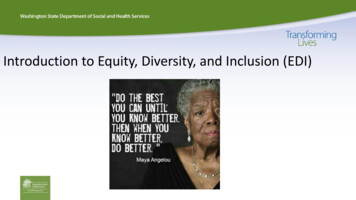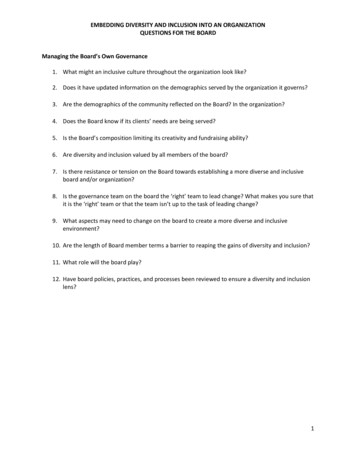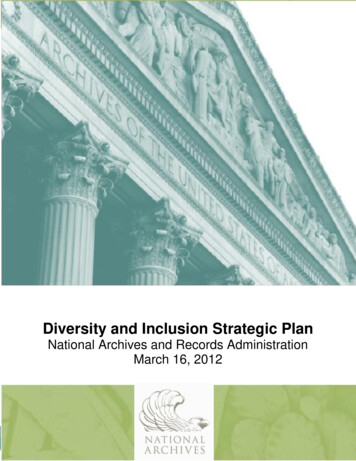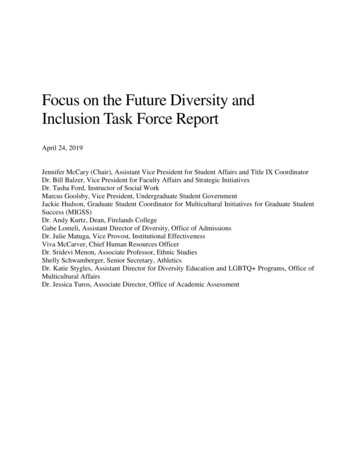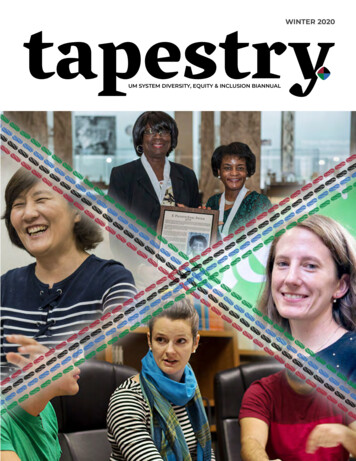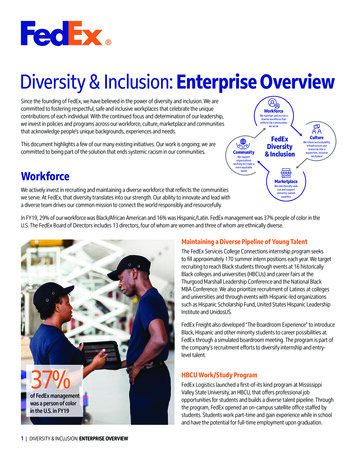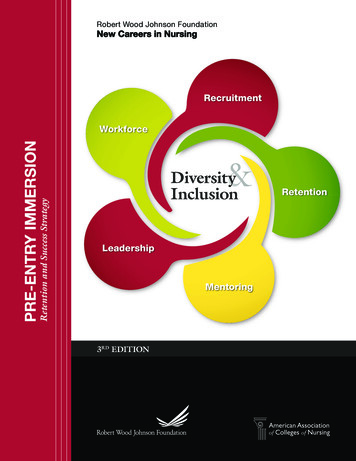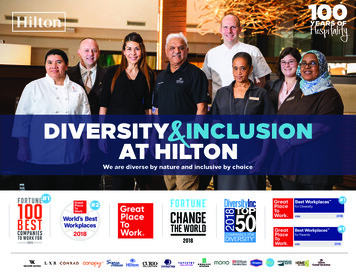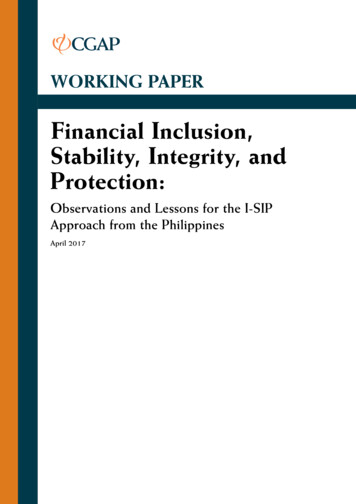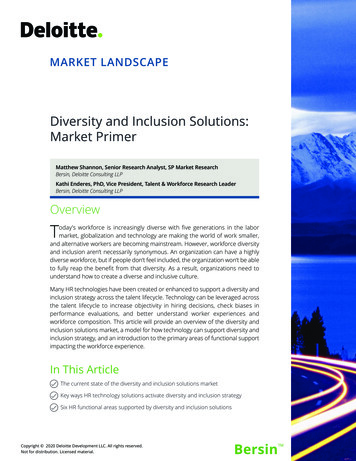
Transcription
MARKET LANDSCAPEDiversity and Inclusion Solutions:Market PrimerMatthew Shannon, Senior Research Analyst, SP Market ResearchBersin, Deloitte Consulting LLPKathi Enderes, PhD, Vice President, Talent & Workforce Research LeaderBersin, Deloitte Consulting LLPOverviewToday’s workforce is increasingly diverse with five generations in the labormarket, globalization and technology are making the world of work smaller,and alternative workers are becoming mainstream. However, workforce diversityand inclusion aren’t necessarily synonymous. An organization can have a highlydiverse workforce, but if people don’t feel included, the organization won’t be ableto fully reap the benefit from that diversity. As a result, organizations need tounderstand how to create a diverse and inclusive culture.Many HR technologies have been created or enhanced to support a diversity andinclusion strategy across the talent lifecycle. Technology can be leveraged acrossthe talent lifecycle to increase objectivity in hiring decisions, check biases inperformance evaluations, and better understand worker experiences andworkforce composition. This article will provide an overview of the diversity andinclusion solutions market, a model for how technology can support diversity andinclusion strategy, and an introduction to the primary areas of functional supportimpacting the workforce experience.In This Articlea The current state of the diversity and inclusion solutions marketa Key ways HR technology solutions activate diversity and inclusion strategya Six HR functional areas supported by diversity and inclusion solutionsCopyright 2020 Deloitte Development LLC. All rights reserved.Not for distribution. Licensed material.
Diversity and Inclusion Solutions: Market PrimerThe State of the Diversity and InclusionSolutions MarketWhile diversity and inclusion has been recognized as an importantcomponent of organizational culture for decades, it’s only within the lastfew years that society has seen increased awareness on the topic. Themedia and various social movements have helped shed light on theunderrepresentation of women and minorities in the technology industryas well as public admissions and mishandling of sexism and harassmentin the workplace. Through these developments, organizational emphasison diversity and inclusion efforts has become more purposeful andprominent. Traditionally, diversity or sensitivity training programs havebeen seen as a reactive policy to negative behavior. However,organizations are starting to take a more proactive stance and prioritizingdiversity and inclusion as part of a more holistic strategy. Someorganizations are formalizing their focus by appointing a C-suite officersuch as a chief diversity officer or a chief diversity and inclusion officer.Others are extending toward other concepts such as belonging and equity,or are embedding this focus into the CEO’s role.While many organizations and technology providers have their ownposition on the key concepts in this space, the primary lens for looking atthe solutions market in this study—and the primary terminology used inthis research report—is diversity and inclusion.We define diversity as the variety of people and ideas within a company.1Organizations can make specific reference to and even measure and trackthe various types of seen and unseen traits such as ethnicity or race,gender, age, disability, and veteran status that comprise an individual’sidentity. The intersection of these traits2 is what constitutes an individual’s2Copyright 2020 Deloitte Development LLC. All rights reserved. Not for distribution. Licensed material.
Diversity and Inclusion Solutions: Market Primerunderstanding of themselves and an organization’s understanding of itsworkforce composition in comparison to the external world.Inclusion is the creation of an environment in which people feel a senseof respect, belonging, safety, and authenticity.3 These feelings combinedis what helps constitute people’s perception of their involvement in theworkplace. Metrics can be a powerful tool to gauge perceived experiencesthrough sentiment and workforce experience surveys, which can guideorganizations in shaping their culture and improving productivity.Diversity and inclusion each have different purposes and strategies,4 buttheir execution can serve as part of a holistic strategy as well as anunderstanding of the supporting role HR technology can assume in thatstrategy.Diversity and Inclusion as a Business ImperativeKEY POINT: Diversity is thevariety of people and ideaswithin a company. Inclusionis the creation of anenvironment where peoplefeel a sense of respect,belonging, safety, andauthenticity.The need for a holistic strategy for diversity and inclusion is not just aproduct of shifting trends with technology and demographics. There is aworkforce expectation and, more importantly, a business imperative topromoting diversity and inclusion.Millennials, as the most diverse generation to date and the largestgeneration in today’s workforce, view inclusion as a mandatory part ofcorporate culture that defines how the company listens to them at work.They believe that businesses should create a culture that encouragesdiversity, inclusion, and social mobility.5 As well, more than 66 percent ofexecutives rate diversity and inclusion as an important issue, and 78percent of organizations believe that having a diversity and inclusionstrategy is a competitive advantage.6Our High-Impact Diversity and Inclusion research found a variety ofbenefits associated with inclusive cultures, including improvedperformance, agility, innovation, business outcomes, and financial results(see Figure 1).73KEY POINT: Organizationsthat create an environmentwhere people feel valuedand respected also enablethem to perform better oncritical outcomes.Copyright 2020 Deloitte Development LLC. All rights reserved. Not for distribution. Licensed material.
Diversity and Inclusion Solutions: Market PrimerFigure 1: The Benefits of an Inclusive Culture in a High-PerformingOrganizationSource: High-Impact Diversity and Inclusion study, Bersin, Deloitte Consulting LLP, 2017.Yet, despite these encouraging statistics, only 12 percent of organizationshave an inclusive culture.8 In contrast, 40 percent of organization areprimarily focused on compliance when it comes to diversity and inclusion.9HR Technology: Dedicated and Supportive SolutionsRecognizing the urgency and importance for strategic investment,organizations need to understand how HR technology solutions canactivate their diversity and inclusion strategy.New expectations and business imperatives around diversity and inclusionare focused on experiential learning, process change, data-driven tools,transparency, and accountability.10 But the technologies to supportdiversity and inclusion can appear in a range of solutions that support thetalent lifecycle from talent acquisition to people analytics.While capabilities to support diversity and inclusion work can be found inmany categories of solutions, they are also evident in different levels offocus for HR organizations. Some solutions are explicitly dedicated todiversity and inclusion efforts, whether through solution or capabilityname, description, or intent. For example, a talent sourcing solution couldtarget job advertisements and listings to a specific demographic groupbased on sex or race. In contrast, other solutions can be implicitlysupportive of diversity and inclusion efforts through the effect, impact, orimplication of a solution or capability. An example of a solution with thistype of supportive focus could be a performance management solutionthat offers an objective approach to evaluating performance and highperformance. This type of support tends to be more objective andprovides structure to help limit the influence of human bias from theevaluation decision.4Copyright 2020 Deloitte Development LLC. All rights reserved. Not for distribution. Licensed material.
Diversity and Inclusion Solutions: Market PrimerDiversity and Inclusion Functional SupportAreasJust as organizations need a more holistic strategy for supporting diversityand inclusion across the talent lifecycle, so too can the HR technologymarket offer support for diversity and inclusion work in different categoriesof solutions.Yet, the diversity and inclusion solutions market isn’t as transparent asother segments of HR technology markets (e.g., talent acquisition orperformance management). For instance, an application tracking system(ATS) is clearly recognized as a talent acquisition solution, but it may alsooffer capabilities that support people analytics activities of measuring andtracking representation of diverse categories throughout the candidateapplication experience. As such, most HR technology solutions categoriescan offer either dedicated or implicit support to diversity and inclusionefforts across multiple functional areas.To best represent the range of capabilities solution providers offer acrossthese areas, Figure 2 lists six HR functional areas where technology actsas a catalyst of diversity and inclusion strategy.KEY POINT: HR technologysolutions for diversity andinclusion are eitherexplicitly dedicated to orimplicitly supportive ofdiversity and inclusionefforts.Figure 2: Technology’s Role in Diversity and Inclusion Support acrossthe Talent LifecycleSource: Bersin, Deloitte Consulting LLP, 2019.Across the solution providers categories that participated in this study—including human capital management suites, talent management suites,talent acquisition solutions, workforce experience and engagementsolutions, people analytics solutions, and pure-play diversity and inclusionsolutions—the functional support areas offered most included talentacquisition (63 percent), people analytics (60 percent), and workforceexperience and engagement (47 percent). The areas least covered by theproviders that participated in our study were rewards and recognition (27percent) and learning and development (37 percent).5KEY POINT: The functionalareas most supported bysolutions with diversity andinclusion capabilities aretalent acquisition andpeople analytics.Copyright 2020 Deloitte Development LLC. All rights reserved. Not for distribution. Licensed material.
Diversity and Inclusion Solutions: Market PrimerTalent AcquisitionTalent acquisition is often one of the first areas for addressing diversityand inclusion challenges because it offers an organization the opportunityto bring in a more diverse workforce. Not surprisingly, 63 percent ofsurveyed solution providers offer support in this functional area.There are many activities across the candidate experience—from initialsourcing through evaluations and hiring decisions—that can be supportedwith HR technologies such as ATS, candidate relationship managementplatforms, and pure-play sourcing solutions, among others. Whilecapabilities for addressing bias in talent acquisition activities are stilllimited,11 the ability to anonymize personally identifiable information inresumes and applications to help mitigate potential human bias fromaffecting evaluation decisions is a common capability. On the moretechnical side of capabilities, some solutions can suggest languagechanges to job requisitions to make them more inclusive and more likelyto generate interest among various demographics. Other solutions canreview candidate communications and recommend ways to be moreinclusive based on legal principles and training content.12People AnalyticsOf the providers that participated in this study, 60 percent support peopleanalytics—the second most commonly supported functional area. Peopleanalytics capabilities complement talent acquisition, which focuses on theopportunity to bring new talent into an organization and betterunderstand its state of diversity and inclusion.There are a multitude of worker identity traits and expressions of inclusionthat people analytics tools can measure and analyze. While primarysystems of HR information management like human capital managementsystems and ATSs commonly capture legally required informationregarding ethnicity, gender identity, age, education, and disability, pureplay people analytics and workforce experience solutions can analyze mostany type of worker identity information that organizations view as avaluable part of their holistic strategy. Inclusion analysis is one of the topthree most common out-of-the box uses cases offered by people analyticssolutions.13 Inclusion-related capabilities within people analytics solutionscan help identify certain business units or teams that aredisproportionately represented compared to other groups and thensuggest reasons why.Workforce Experience and EngagementSimilar to people analytics functional support, which focuses on thegathering and analyzing of data around diversity and inclusion, workforceexperience functional support focuses on the collection and assessmentof workforce experience and engagement data. Solutions in this categoryof support can offer capabilities for measuring worker sentiment aroundsuch inclusion metrics as belonging, psychological safety, feeling valued,and opportunity. Insights from workforce experience measurement andanalysis can provide greater perspective into the experiences of inclusioncompared to reporting on representation. Further, some solutions can6Copyright 2020 Deloitte Development LLC. All rights reserved. Not for distribution. Licensed material.
Diversity and Inclusion Solutions: Market Primeralso offer suggested actions to help improve the inclusion experienceacross the workforce.Talent ManagementTalent management can include a range of activities from talent acquisitionto performance management to learning and development. For the focusof capabilities that support diversity and inclusion in this study, talentmanagement indicates the activities of performance management, highpotential identification, coaching, and mentoring.HR technologies—whether available as
Diversity and Inclusion Solutions: Market Primer Overview Today’s workforce is increasingly diverse with five generations in the labor market, globalization and technology are making the world of work smaller, and alternative workers are becoming mainstream. However, workforce diversity and inclusion aren’t necessarily synonymous. An organization can have a highly diverse workforce, but .

